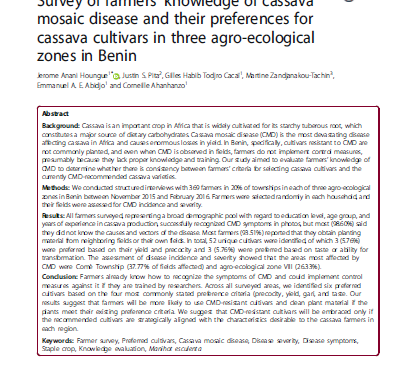Cassava is an important crop in Africa that is widely cultivated for its starchy tuberous root, which constitutes a major source of dietary carbohydrates. Cassava mosaic disease (CMD) is the most devastating disease affecting cassava in Africa and causes enormous losses in yield. In Benin, specifically, cultivars resistant to CMD are not commonly planted, and even when CMD is observed in fields, farmers do not implement control measures, presumably because they lack proper knowledge and training. This study aimed to evaluate farmers’ knowledge of CMD to determine whether there is consistency between farmers’ criteria for selecting cassava cultivars and the currently CMD-recommended cassava varieties. We conducted structured interviews with 369 farmers in 20% of townships in each of three agro-ecological zones in Benin between November 2015 and February 2016. Farmers were selected randomly in each household, and their fields were assessed for CMD incidence and severity. All farmers surveyed, representing a broad demographic pool with regard to education level, age group, and years of experience in cassava production, successfully recognised CMD symptoms in photos, but most (98.60%) said they did not know the causes and vectors of the disease. Most farmers (93.51%) reported that they obtain planting material from neighbouring fields or their own fields. In total, 52 unique cultivars were identified, of which 3 (5.76%) were preferred based on their yield and precocity and 3 (5.76%) were preferred based on taste or ability for transformation. The assessment of disease incidence and severity showed that the areas most affected by CMD were Comè Township (37.77% of fields affected) and agro-ecological zone VIII (26.33%). Farmers already know how to recognise the symptoms of CMD and could implement control measures against it if they are trained by researchers. Across all surveyed areas, we identified six preferred cultivars based on the four most commonly stated preference criteria (precocity, yield, gari, and taste. The results suggest that farmers will be more likely to use CMD-resistant cultivars and clean plant material if the plants meet their existing preference criteria. We suggest that CMD-resistant cultivars will be embraced only if the recommended cultivars are strategically aligned with the characteristics desirable to the cassava farmers in each region.
Region: Benin
Date published:
2018
Published by:
Journal of Ethnobiology and Ethnomedicine
Type of resource:
Journal article
Resource topic:
Cassava
Project/Programme: Not specific
Pest/Disease: Cassava mosaic virus
Pages:
9
File type:
External link (1,270 KB)




